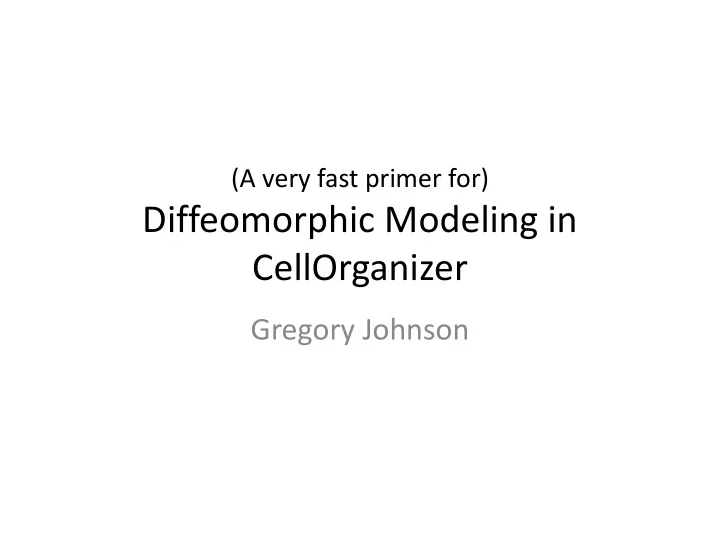

(A very fast primer for) Diffeomorphic Modeling in CellOrganizer Gregory Johnson
Diffeomorphic Models • Uses Large deformation diffeomorphic metric mapping (LDDMM) • Morph one shape to another • Builds “shape space” • Allows for walks through shape space that could be used to describe cellular dynamics
WHY?
Motivation • Cells don’t always satisfy assumptions of parametric models. Segmented PC12 cell Star-polygon ratio model representation
Generative Images showing shape model real shapes Parametric shape space models 5 Keren et al. 2008
Shape space 6 Keren et al. 2008
Limitations of common outline model Maryann Martone/CCDB 7 Srivastava et al. 2005
Limitations of common outline model Distance from center of distribution
LDDMM - Large Deformation Diffeomorphic Metric Mapping
What is a diffeomorphism? • Essentially a smooth and invertible mapping from one coordinate space to another A diffeomorphic mapping from Diffeomorphic mappings of continents to a regular rectangular grid. a 2D projection of a globe https://en.wikipedia.org/wiki/Diffeomorphism http://wwwx.cs.unc.edu/~mn/classes/comp875/doc/diffeomorphisms.pdf
A diffeomorphic mapping from one image to another. http://wwwx.cs.unc.edu/~mn/classes/comp875/doc/diffeomorphisms.pdf
Nonparametric shape image-based models Real 2D nuclear shapes Peng et al. 2009 Cannot just interpolate images as if they were vectors 12 http://alumni.media.mit.edu/~maov/classes/comp_photo_vision08f/
Morphing to interpolate images 13 http://alumni.media.mit.edu/~maov/classes/comp_photo_vision08f/
Distance between two shapes Work so far Distance Shape A Shape B 0 0.0165 0.0191 0.0194 0.0195 Peng et al. 2009 0 0.0165 0.0191 0.0194 0.0195 Iterative reduction in difference between deformed shape A and B Distance Distance = total work across all iterations 14
LDDMM - Large Deformation Diffeomorphic Metric Mapping • Minimal energy transformation with respect to the gradient of the deformation field i.e. Geodesic distance A diffeomorphic mapping from one image to another. Shadel 1974 http://wwwx.cs.unc.edu/~mn/classes/comp875/doc/diffeomorphisms.pdf
f1.png 0.8 0 0.2 0.4 0.6 1
LDDMM shape spaces model joint distribution across morphological features 17
Diffeomorphic Training
Shapes to Space MDS But this takes a lot of time
Partial Distance Matrix Learning • Most complete shape space MDS
Partial Distance Matrix Learning • Landmark MDS Nystrom Approximation MDS ?
Diffeomorphic Synthesis
Space to Shapes ? Synthesis strategy for new points
Modeling the distribution of shapes Modeling distribution of shapes – p(x) • The shape space defines an implicit Nonparametric density estimation probability density. p(x) = 1/v i n x ?
Modeling distribution of shapes – p(x) Shape space modeled as a Gaussian Mixture Model n = 2 n = 1 Parametric Representation Gaussian mixture model 2 components n = 3 n = 4
Diffeomorphic space • New feature space – Positions in space correspond to a real image – Feature dimensions correspond with dimensions that with highest eigenvalues – Can be treated exactly like a normal feature space
HeLa shape space with DNA intensity DNA intensity Component 2 (R 2 =0.08) Component 1 (R 2 =0.04) Component 3 (R 2 =0.57)
Minimum energy pathway reconstruction example t = 1 t = 2 Plausible Lower net distance traveled Matched points are more similar Less Plausible Greater net distance traveled Matched shapes less similar Solution: Minimum global weight bipartite matching
Minimum energy pathway reconstruction example t = 1 t = 2 t = 3 t = 4 Minimize net flow while min(max(w) - min(w)) Constraints Travel along shortest path on d 2
Procedure • Construct distance matrix • Construct neighbor graph • For each interval: t i to t i+1 Find shortest path from each observation in t i to every other cell in t i+1 Find transition pairs via minimum weight bipartite matching • Construct transition pathways
Recommend
More recommend